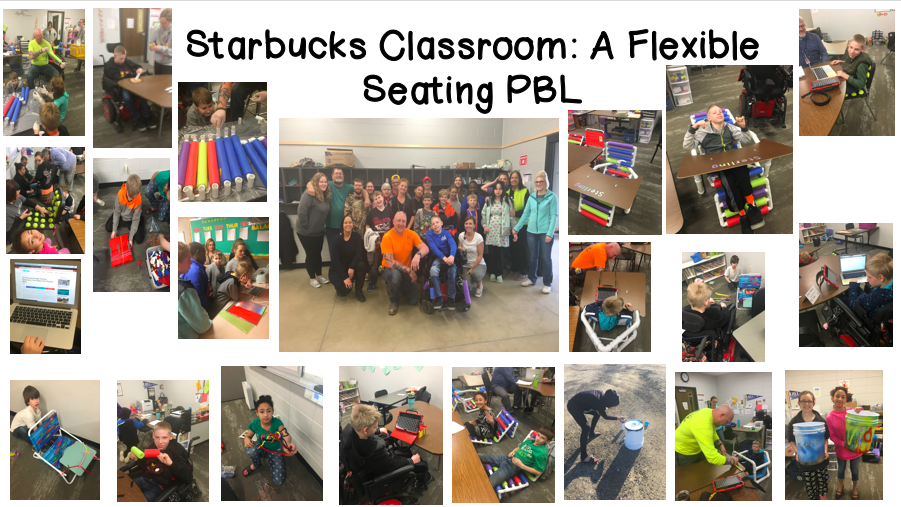
What Is Flexible Seating?
The Starbucks Classroom PBL is a flexible seating project-based learning opportunity. What is flexible seating? As a teacher, you know that flexible seating is EVERYWHERE!!!! It is usually designed and implemented by the classroom teacher, without much if any help from students. Flexible seating has many benefits in classrooms. It gives students the choice and comfort that traditional seating fails to offer. Flexible seating could include beach chairs, exercise balls, wobble chairs, floor pillows, tall cafe tables, standing desks, and much more. Flexible seating options differ from classroom to classroom, but it’s all based on the same idea. The idea is to give students flexible seating options to improve comfort, increase student choice and allow more movement during learning, thus improving engagement.
What Is A Starbucks Classroom?

A Starbucks classroom is a classroom that is designed with the same concept as your favorite Starbucks restaurant. This includes multiple flexible seating options. It is a relaxed environment that is not only conducive to learning but one that invites communication, collaboration, and creativity.
Why Turn It Into A PBL?
Why not is the question that I will ask! Inspiration for a PBL can come from anywhere and is usually created based on a need. Why not turn what you were already going to create into a real-world learning project for your students? I consider it a double bonus. A real-world learning experience for your students and in this case, custom flexible seating for your classroom. The Starbucks Classroom PBL was designed based on the need to find comfortable flexible seating for all physical and sensory needs.
The Role Of A PBL Teacher
PBL involves changing teacher practice. In a PBL, students take the reins, and teachers are encouraged to take on more of a facilitator role. In a high-leverage PBL, the teacher spends most of their time organizing, probing students about their own sense-making and acquisition of skills, promoting critical thinking, growth, and engagement, and planning instruction based on need and understanding students. PBL teachers encourage student voice and choice. The best PBL teachers seek to understand their students, then create a driving question and plan instruction based on student needs. They also set high standards and require students to use evidence to back up their thinking.
Inspiration For This PBL
I am a K-12 Instructional coach. The idea for this Starbucks Classroom PBL came out of a conversation with one of our middle school special needs teachers. She had always wanted to try flexible seating with her students but wasn’t sure how it would work for all of the different physical and academic needs in her extremely small classroom. This teacher was going to try out some different options when the idea came about to turn this into a project-based learning (PBL) opportunity for her students.
She had a few students with sensory needs including autism and ADHD and one non-verbal student in a mechanical wheelchair that used a communication device. The student in the wheelchair had never been able to sit in anything other than a standard chair with adaptations or his wheelchair. In his 7 years of schooling (6th grader) he had never had a floor seat option. This factor drove the project.
Context
The Starbucks Classroom PBL: Our classroom needs help! We have some very uncomfortable chairs that need to be redesigned. We also need a more inviting space where students can focus better.
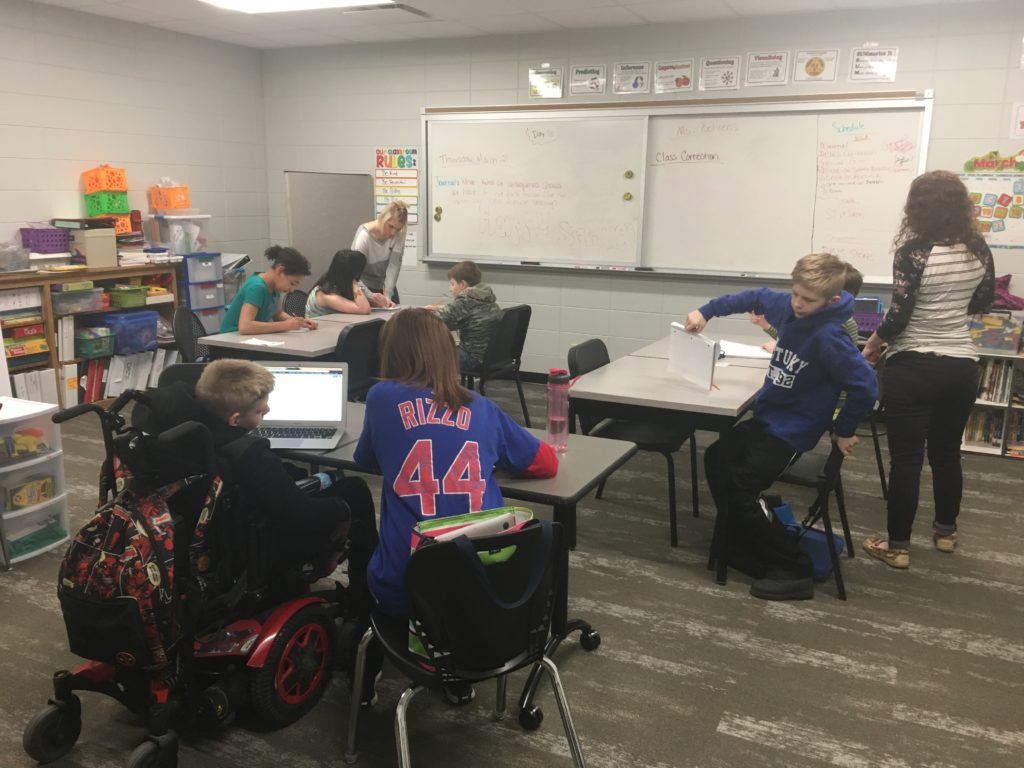
Learning Outcomes:
- Research Strategies- pulling information and ideas from researching the best solution (ELA) W.7
- Writing opinion piece and a quality interview/ data collection type question to gain information from others (ELA) W.2-5, W.10, RI.1
- Collaboration, communication, and problem solving (21st Century Skills)
- Measurement- inch, foot, area, perimeter….. (Math) MD.B.4, MD.C.5-7
- Safety- using a hammer, staple gun, glue gun……. (Life Skills)
- Reading and informational text using text features and close reading (ELA) RI.5, RI.9
- Demonstrate and describe processes used in developing, evaluating, and improving on structures that will meet human needs with a margin of safety. (Science)
The Driving Question
All good PBLs have a driving question. The driving question is the focus of the entire project. The driving question for the Starbucks PBL is: How can we make flexible seating accessible for all physical needs?
Tangible Outcomes
- Flexible seats for the classroom
- Information fliers for each type of flexible seat
- Flexible seating survey and interview questions
- Rules/procedure posters/cards for each flexible seat station
The Challenge
This Starbucks Classroom PBL was set up as a design challenge. We challenged the students to create flexible seating options for all physical and sensory needs, including giving the student in the wheelchair a floor option. Another challenge to this project was the extremely small space we were working with. Students had to keep in mind how the seating options would be stored, look for options that could double as storage, and make sure that there was enough space for the wheelchair and evacuation if needed.
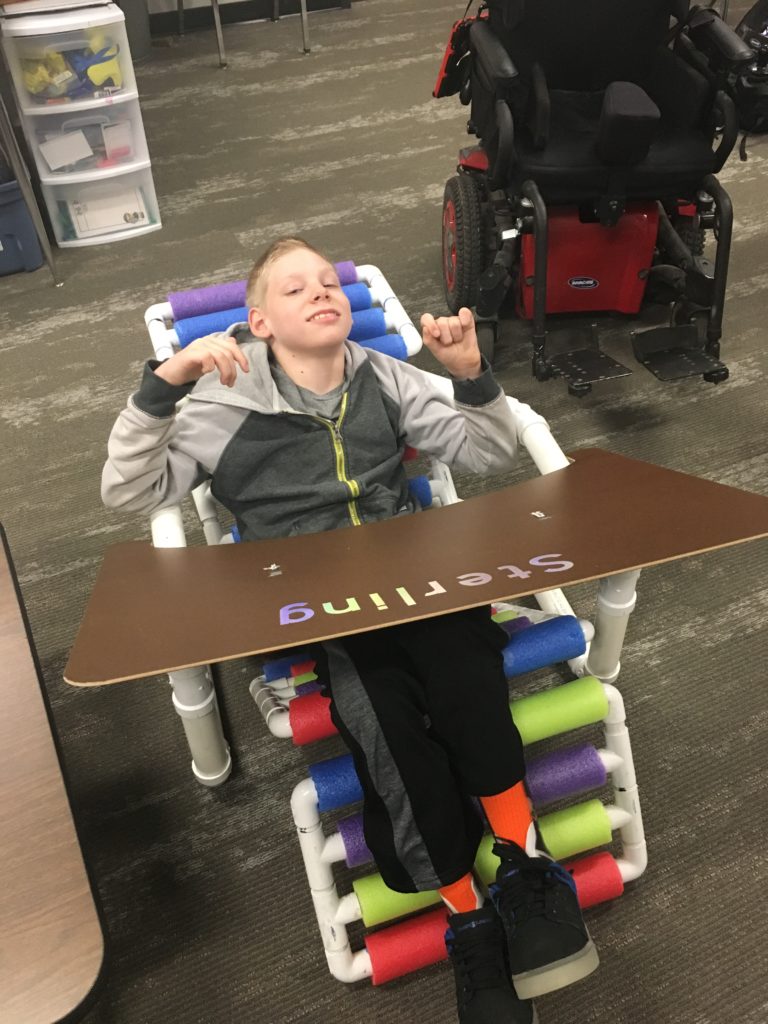
How Does This PBL Work?
Create A Snapshot
First things first, we had to come up with a snapshot of what we wanted the students to do with this project. We decided that for the Starbucks Classroom PBL, we wanted the students to become our classroom furniture designers and conduct research on the benefits and drawbacks of flexible seating. This will help with choosing options that fit best in your classroom.
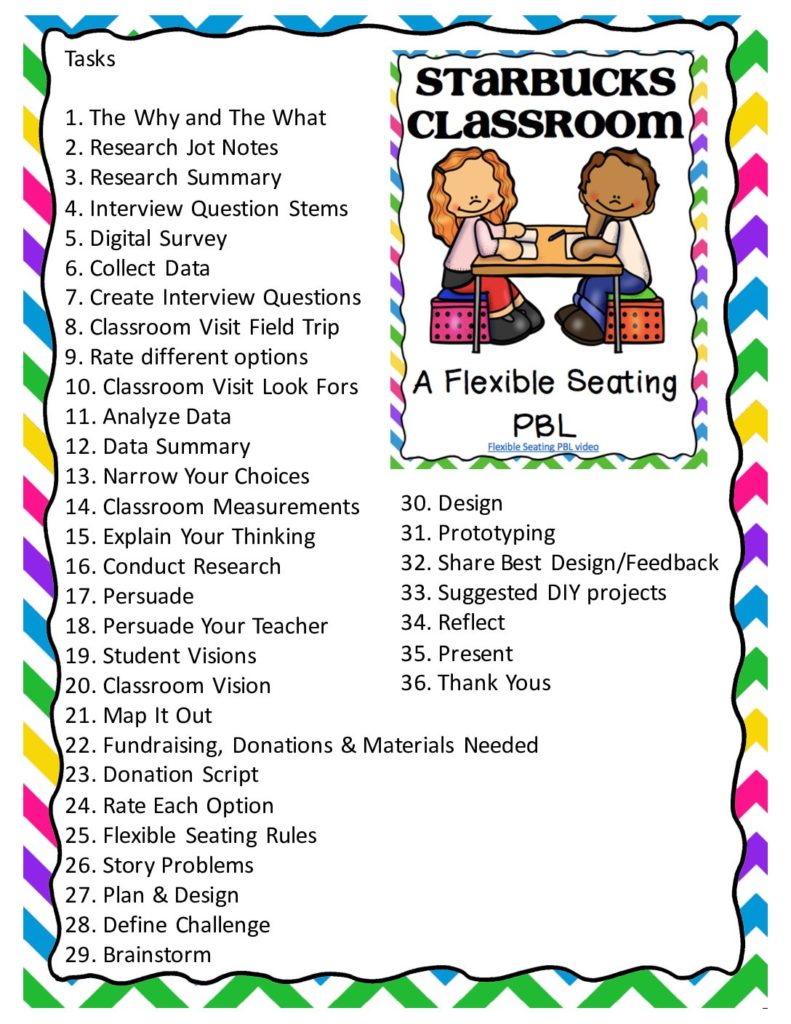
Create A Vision
As a class, we came up with a vision of what we wanted flexible seating to look like in our classroom. Your vision serves as the driving force of how you will use flexible seating in your classroom. Create a vision statement with your students. The vision we came up with for the Starbucks Classroom PBL was that we wanted to create comfortable flexible seating for all physical and sensory needs.
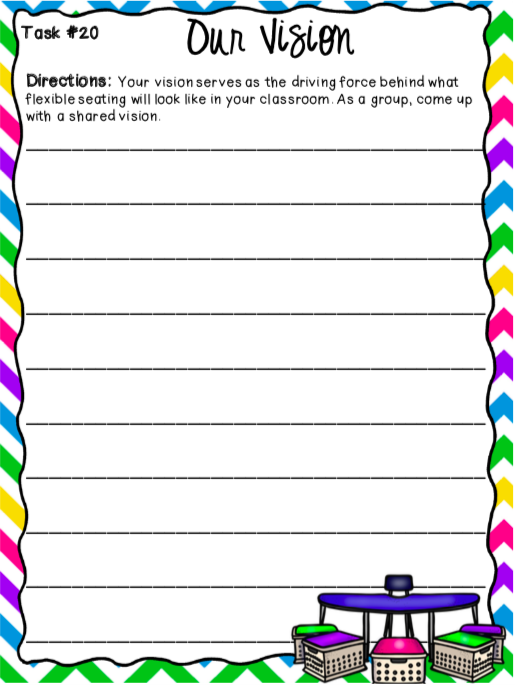
Classroom Visits
Students were required to collect data from others. They took a field trip to other flexible seating classrooms to try out different options and see how they worked in the physical space. The teachers we contacted were more than happy to invite the students in and participate in interviews. The students had a few classroom visit look fors that they were required to take notes on including the types of flexible seating they saw, how the students chose their seating options, rules of flexible seating, storage of the seating options, and if any option would work for all physical needs.
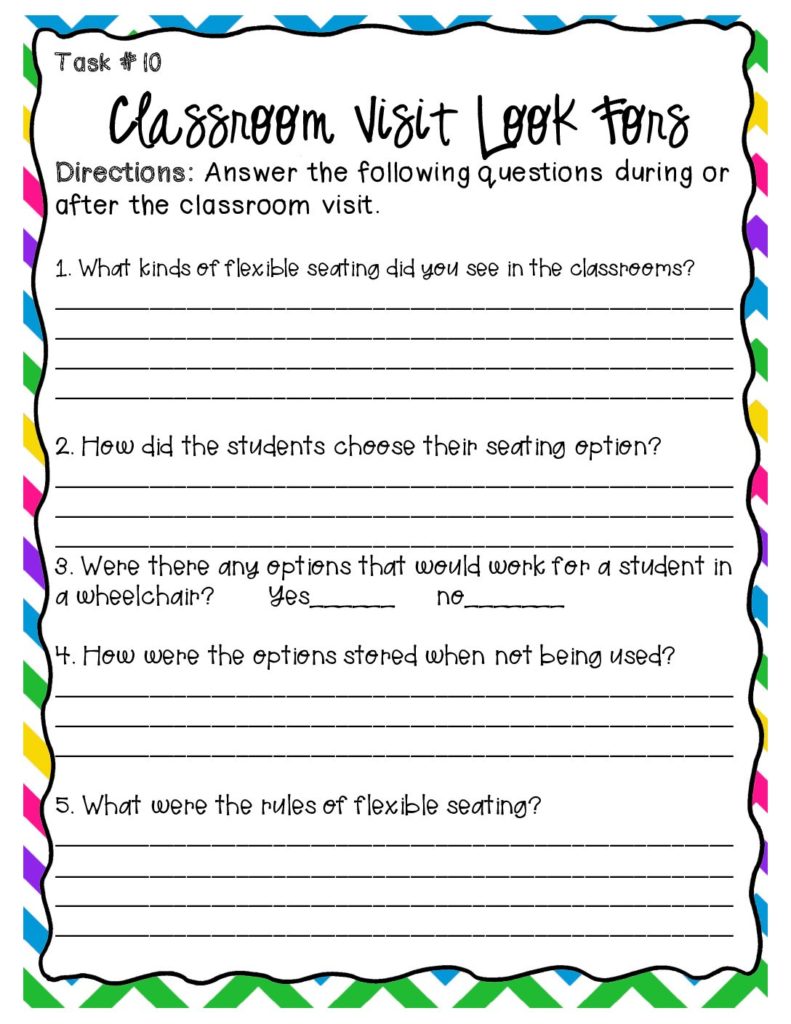
They visited Kindergarten, 1st grade, 4th grade, middle school, and high school flexible seating classrooms. They also had to try out each option and list the pros and cons of each.
Collect Data
Our students created a digital survey (Google Form) to collect data from the students about their preferences.
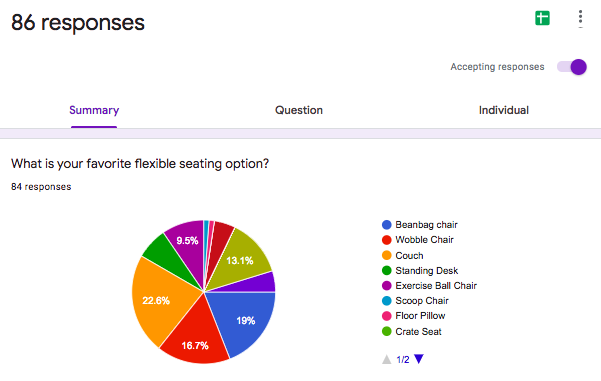
The goal of the student survey was to figure out what the most popular option was amongst students as well as the most comfortable options available. They also used a visual survey that they marked when visiting the classrooms to figure out which options teachers were using. Our students then graphed the results to see what the clear winner was.
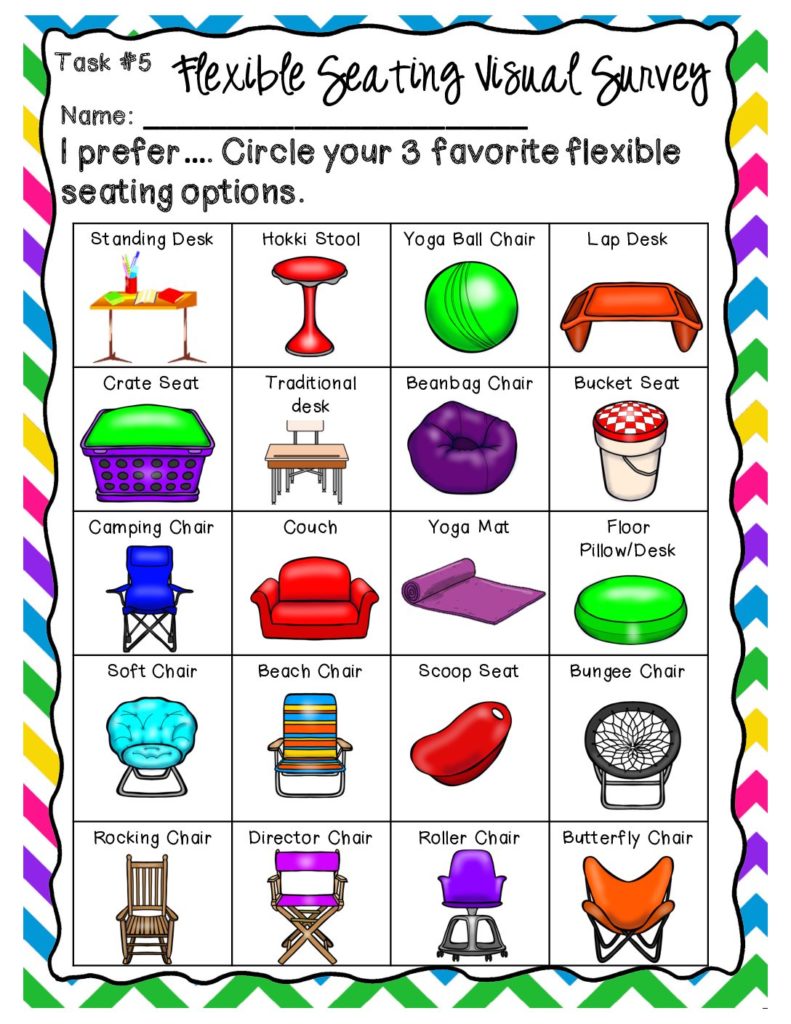
During this visit, they interviewed students and teachers of that classroom about their feelings on flexible seating to figure out what works and what doesn’t as well as get an idea of how the current seating options in those classrooms have changed from the original plan. I found it helpful to have a student video the interviews and other students to take pictures of the physical environment and seating options. This way the students can use the videos as part of their research or things to keep in mind when making decisions on what options work best in your classroom.
Inquiry & Research
The students had to figure out what flexible seating options would work best for our small classroom and student needs within the classroom. We had our students each choose one form of flexible seating to conduct research on. An option that they would like to see in the classroom. They were looking for the pros and cons of that flexible seating option, the cost, and the benefits to students. The students then had to write a persuasive piece to persuade their class to choose their option. They then presented their argument to the class. The class voted on final seating options after hearing every student’s arguments for their option.
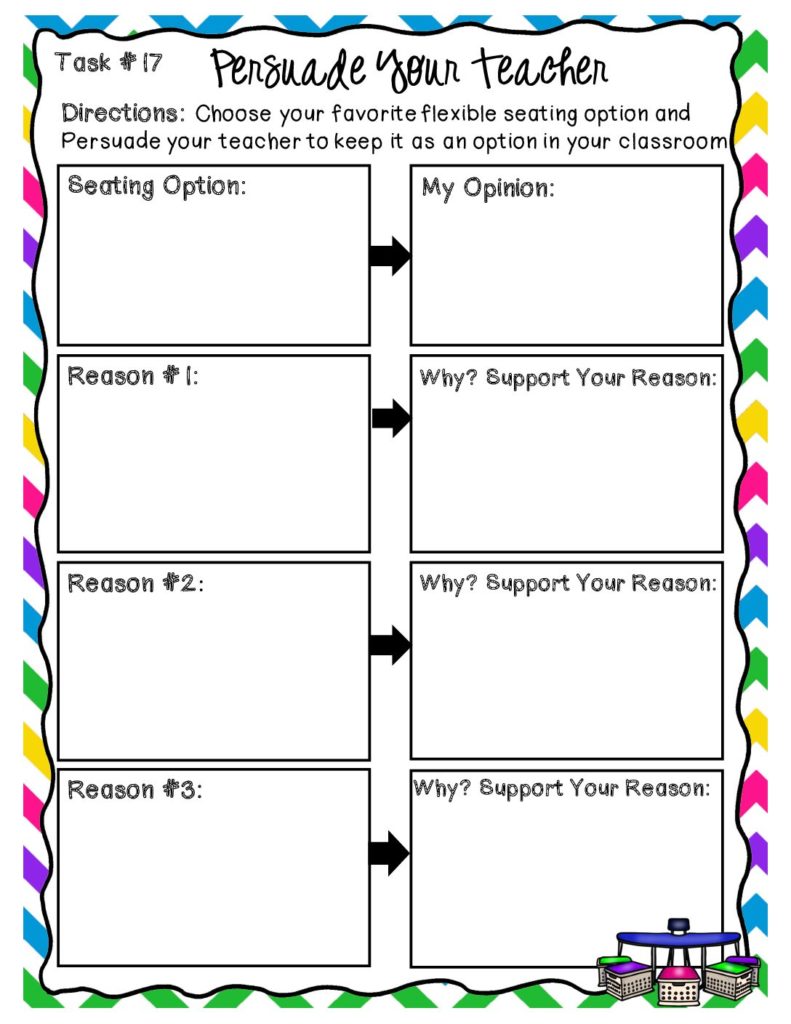
The students were also tasked with the job of figuring out what materials we would need, the cost of materials, ideas on where we could get the money to purchase everything, and who we would need to recruit to help us build the custom seat. They also had to measure and map out the classroom and decide where everything would go. The students had to keep in mind that we had an extremely small classroom so they would need to come up with seating options that double as storage. In addition to the small space, the students had to consider every student’s physical and sensory needs.
Interview A Client
The students interviewed their client (student in the wheelchair) who they were custom making a floor seat to see how they could design something to fit his specific needs. They asked questions about what this student has tried in the past, what was comfortable to him and what he wanted to try. They found out that this student has never had a floor seat option and has only been able to sit in his wheelchair or a standard chair with adaptations. He also has a standing option but only uses the standing chair during his occupational therapy. He really wanted a floor option like his peers.
They also interviewed his occupational therapist for things to think about when looking to create something to fit his needs. She helped the students with specific measurements and gave suggestions about how to fit his needs. All questions were designed and asked by the students. If you are thinking about making a flexible seating classroom without making a custom seating option for a specific need the teacher would make a great client. Questions to the teacher could include color, number of options, preferences, and storage capabilities.
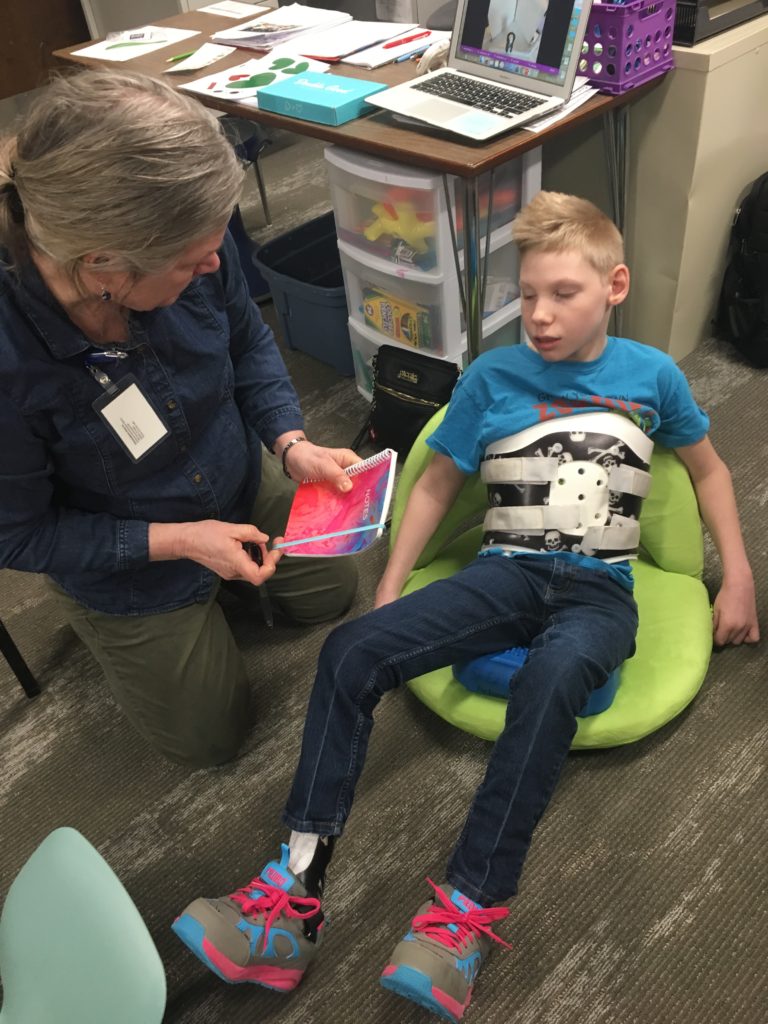
Create A Budget
Before figuring out how we would get the money to fund this project the students had to first figure out specifically which options would work best in our space and how much money we would need. They created a visual budget. The visual budget was used as part of the presentation piece. We presented our needs to local businesses. This included specific items, where they would be ordered from, the quantity, and the total cost. The students decided on designing pool noodle chairs made out of PVC pipe and pool noodles, 5-gallon bucket seats, standing desks, and tennis ball chairs. The pool noodle chairs were easily foldable and slim for storage, the bucket seats fit our low table and doubled as storage and the tennis ball chairs worked well with the different sensory needs.
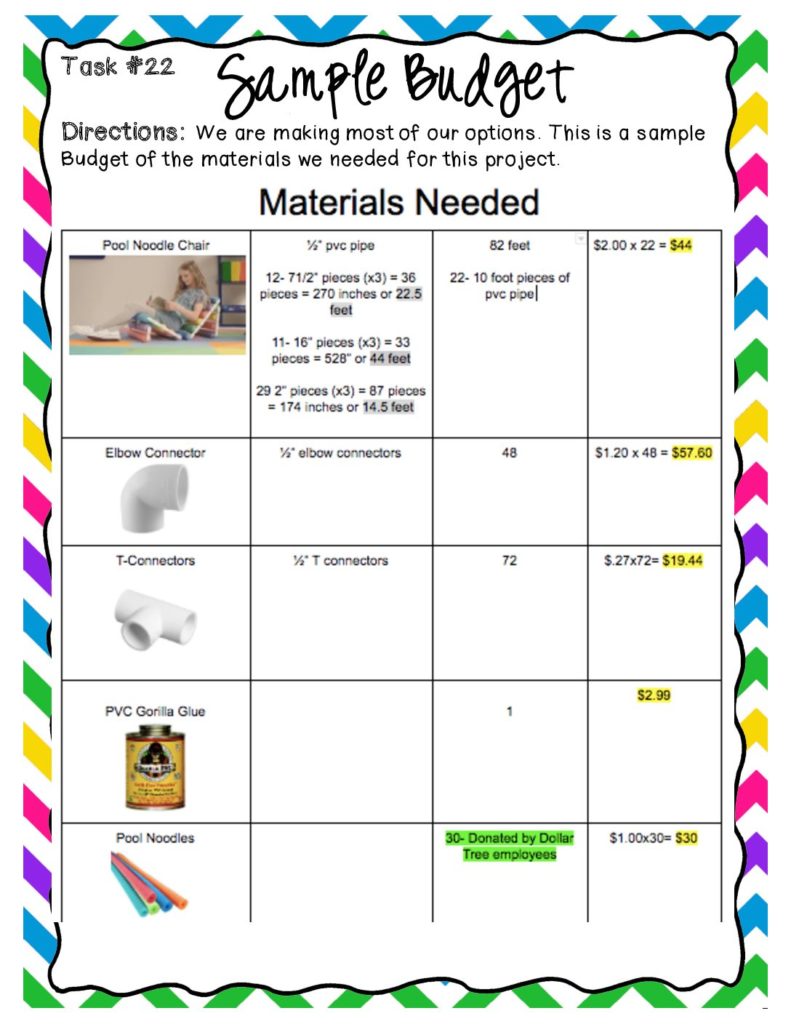
Design A Sales Pitch
The class as a whole had to come up with a sales pitch that they would use to get investors. They wrote a script, which included the benefits of flexible seating, the motivation behind creating flexible seating, and our financial needs. They used a lot of the same information from their research and persuasive piece. The students also had to figure out what they were going to present and the presentation order. We practiced this multiple times so that it was perfected for the actual presentations. The script was then presented to local businesses to see if they would be willing to donate toward our project. We (the teachers) called and prepped the businesses ahead of time so that they were prepared to hear their pitch. They were all more than happy to participate.
Strategically Choose Potential “Investors”
I really like to tie the type of businesses we ask with the type of project we are needing support with. I have found that the better the connection is to the project, the more likely they will be willing to help. In the Starbucks Classroom PBL, we were needing some construction-type materials like PVC pipe, PVC glue, and pieces of wood, so we asked the local lumber store, hardware store, and plumbers.
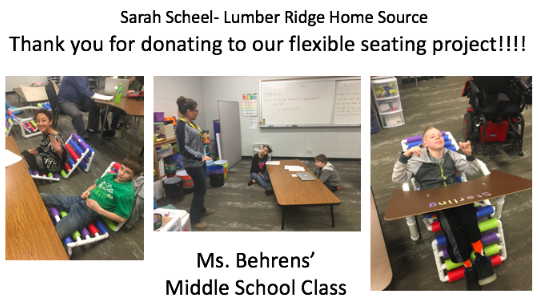
We also worked with our local adults with special needs program to help us create our seating options. They also chose to donate to our project. A huge selling point for businesses to donate to our project was that we would advertise their donation to our project in any social media and news articles when we shared our final project with the world. Don’t forget to have the students create special thank you notes for the donors. All of our donors hung their thank-yous in their stores.
Don’t Be Afraid To Ask
It doesn’t hurt to ask a business or group to donate to your project. The worst that can happen is that they will say no thank you. We have asked for money, time, help with physically creating our project and materials. I have done a lot of PBLs where funding was needed and have asked many businesses and individuals to donate.
I have never been turned down but would understand if they did. The employees of our local Dollar Tree donated the pool noodles. They paid for it out of their own pockets because their company doesn’t donate. Since this was implemented with a special needs class and we wanted our adults with special needs program to help create the seats we also asked them for donations. We easily got the funding. I have found that all of our local businesses are more than willing to help and jump at opportunities to work with the school. The more you can stay local the better!!!
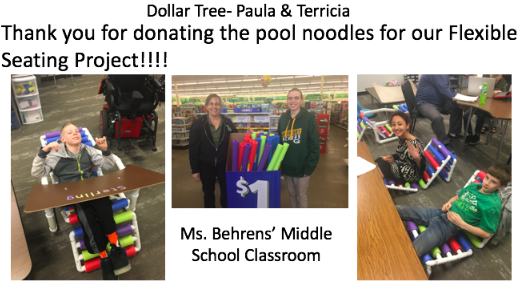
Adult-World Connections
- Meet with construction experts both in house and within the community with help constructing the actual seats
- Interview teachers of flexible seating classrooms
- Pitch our needs to local businesses
- Work with the occupational therapist.
- Work with the Industrial Tech teacher and students
- Invite the adults with special needs program in town to help create seating options
This turned out really amazing!!! I would suggest that if you choose to create a Starbucks Classroom with your class that you consider inviting your local adults with special needs program in to help you or your special needs students, even if you are in a gen. ed. classroom. It’s super rewarding for the students and the clients alike.
Our local adults with special needs program is always looking for activities that their clients can help within the community. It’s seriously a win-win! Just make sure that you follow your school policy on visitors. All of the clients that wanted to help had to go through our background check process as any other visitor would. We also had the adults with special needs program choose the clients that were interested in helping and would work best with this project.
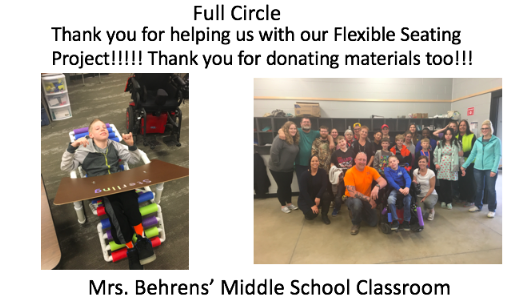
Many of the students in the special needs class have relatives as clients at the special needs adult program in town and will most likely use their services after graduation. Another aspect of working with the adults with special needs program was that we were building those relationships early on so that if and when they joined that program they would already know others, have relationships built, and would have a smoother transition. They would also be more likely to take advantage of their services in the future.
Our Industrial Technology teacher was more than happy to help us with the construction of the custom seats. He had his class help our students with measuring, cutting, and putting our seats together. The class helped with everything including creating the custom seating option. This gave his class a great project to work with another class on. The high school students were patient, asked great questions, were excited to help their underclassmen and really stepped up to show leadership skills. This was a true collaboration between two classes and an amazingly rewarding experience for all students.
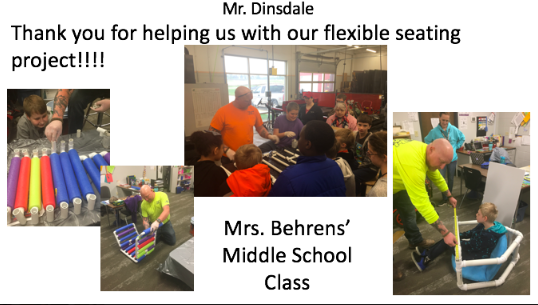
In the Starbucks Classroom PBL, the students were in charge of everything, with our guidance and direction. This project was focused on ELA, Math, and 21st Century Skills. We taught mini-lessons on safe online research, question writing, research strategies, text features, data analysis, money, measurement, area and perimeter, and how to ask and answer questions. The students worked on problem-solving roadblocks as they arose, goal setting, meeting a timeline, sticking to it, and communication. They also learned about prototyping and adjusting their design along the way.
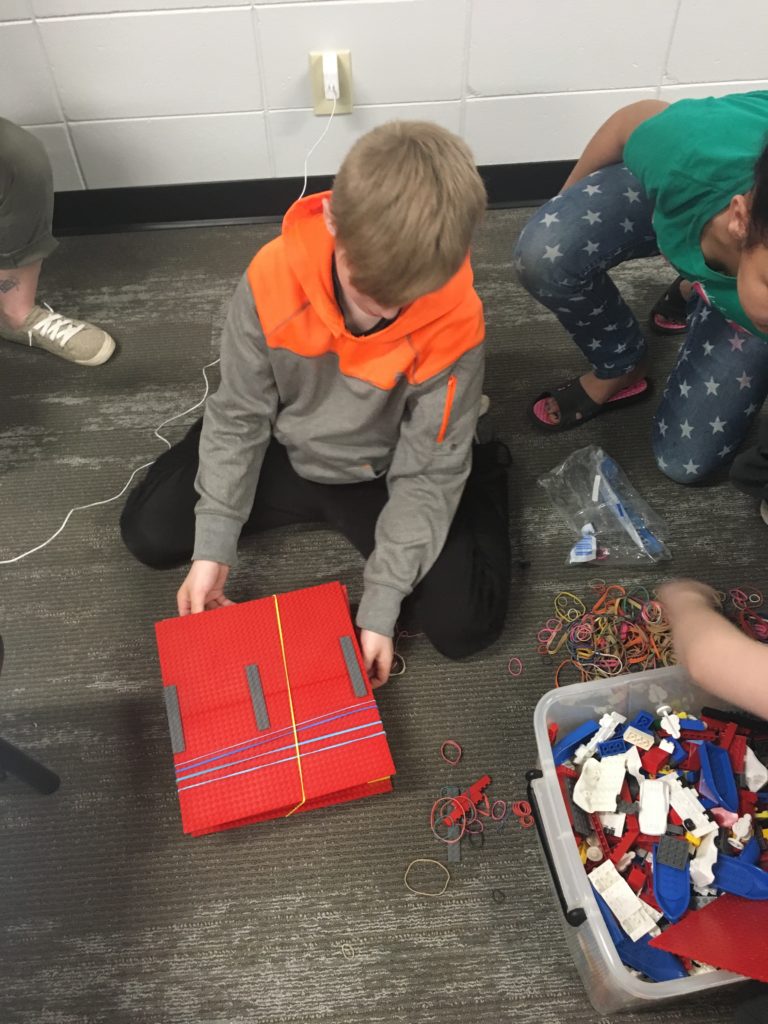
Drafting & Mini Model
Now comes the fun part. Each student first started with creating a drawing of what their custom floor seat would look like. They then used craft materials along with Legos to build a mini model of their custom seat. We put out every craft material we could find. The students were then challenged to create a prototype. The mini model was really helpful when it came to building a prototype. We worked with the industrial tech class to create the prototypes.
Prototyping & Building
A prototype is the first full-sized model of what the actual seats will look like. A sample that serves as the test model. A prototype is very important. Prototypes allow designers to work out the problems and problem solve by making the necessary tweaks for it to function. We started by working with the industrial tech class to create a prototype of the pool noodle seat that would be used by most students. Once we figured this out we were better able to customize the custom floor seat pool noodle option. We found the directions for the pool noodle seat from this We Are Teachers article.
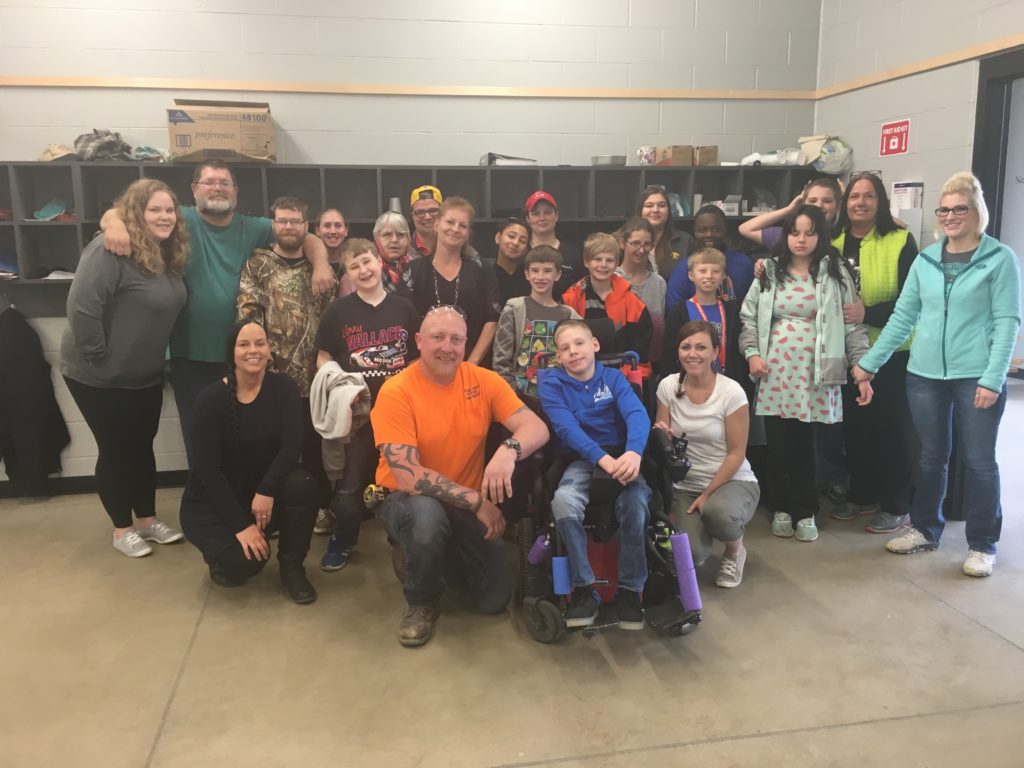
After the prototype was complete we built 4 more pool noodle seats. We invited the adults with special needs program to help build the rest of the pool noodle seats with our students and the industrial technology students. After opening the PVC glue, we found that it is very toxic to breathe so we made sure to work in a very large ventilated area for the safety of everyone helping. We also had everyone wear safety glasses and rubber gloves for safety.
Custom Seat
The custom floor seat was inspired by a Bumbo. The Bumbo is a seat created for infants that can’t sit up on their own without support. They are made of foam and have a piece that fits between the legs and keeps the child upright much like the piece on the client’s wheelchair. It also braces the child to help hold up their core. Our student client can not physically hold himself up without support, so we knew he needed similar support to his wheelchair.
One job of a custom furniture designer is to keep their client’s wants and needs in mind. This particular client is a middle school student with particular physical needs. The student designers needed to keep that in mind when designing a custom option for him. Part of the design goal was not to make our client feel like a baby. Instead, the designers wanted to create something that would be fit for a middle schooler. Something that was similar to what his peers were going to use.

Custom Design
To create the custom floor seat design, students first created the outside support that would help hold the client upright. They customized it by making the bottom one PVC pipe higher than the other pool noodle chairs. They also tweaked the back of the pool noodle chair to fit the outside support brace. The students found the best way to tweak a prototype is to make the tweaks as the student is in it. This made it easier to see what issues needed to be resolved. The students realized that the client needed some type of desk that would attach to the outer brace. This would hold his communication device and computer.
After we created the desk we realized that we needed to make it adjustable. It needed to be able to raise up and down and move closer and farther away if needed. We also realized that his devices would slide so we added a hook for his communication device strap and a stopper for his computer. Our student client was super excited with his finished custom seat and uses it in most of his classrooms. This custom seat should fit him throughout high school.
5-Gallon Bucket Seats
In addition to the pool noodle seats, we also created 5-gallon bucket seats. These fit our low table and doubled as storage. We had the buckets donated by a construction company. These were super easy to create. We had the students spray paint the buckets using donated spray paint. We were initially going to create the seat tops but found that purchasing ice fishing bucket seat pads were actually cheaper so we chose this option instead. They even rotate! We worked with the high school special needs class to use a Cricut machine to print out name stickers for each bucket.
Tennis Ball Chairs
The students conducted all of their own research. During this process, one student found an amazing tennis ball chair idea. Tennis ball chairs are not only super simple to create but work well with all sensory needs including students with ADHD and Autism. To create a tennis ball chair all you need to do is cut a few tennis balls in half and glue them to any chair. These were super easy to create and the materials were easy to get. The high school tennis coach donated all of the tennis balls we needed. All we needed to do was ask.
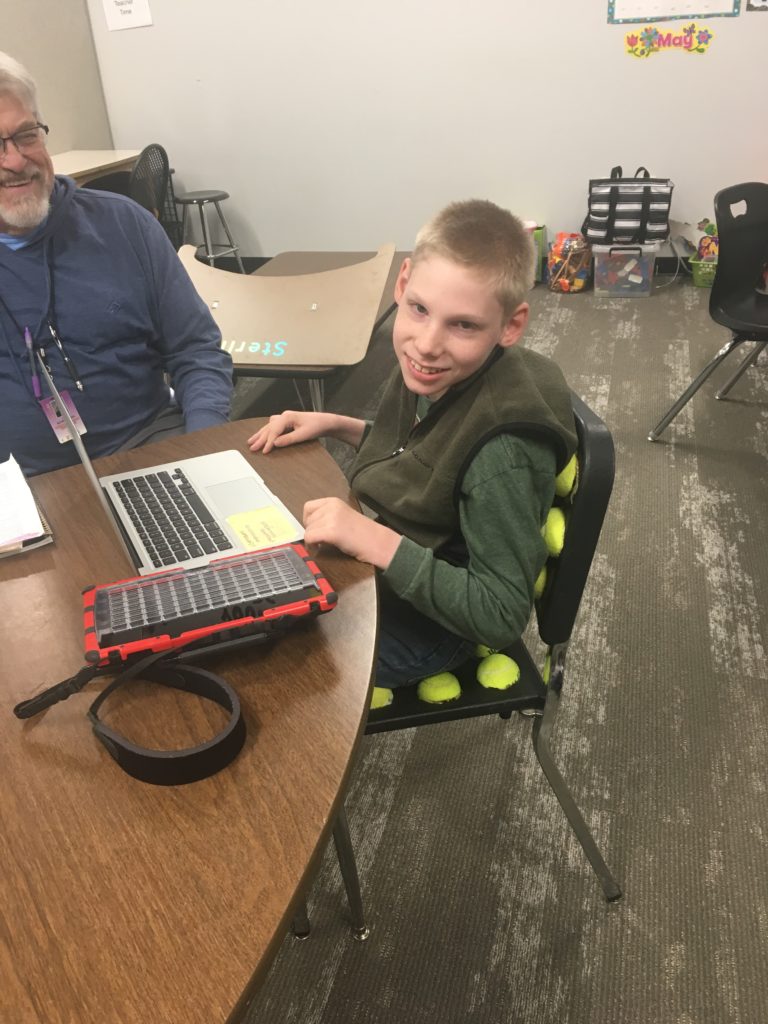
It turns out that every season the older tennis balls that don’t have much bounce left in them are swapped out for new balls. The coach was more than happy to donate the phased-out tennis balls to our project. Since the tennis balls donated by the tennis program were used and a little dirty, the students had to figure out how to wash them before they could be used to create the chairs. They decided to YouTube how to wash tennis balls. It turns out all you need to brighten tennis balls is a little dish soap and warm water.
Do The Math
Math was a huge part of the Starbucks Classroom PBL. The tennis ball chairs were made of tennis ball halves. This forced the students to create a plan for the number of tennis balls needed. The students had to use multiplication and fractions to figure out the specific amount needed for each chair and the total needed for 4 tennis ball chairs. Since we were working with students with special needs, we had to help our students cut the tennis balls in half for safety purposes.
The tennis balls donated by the tennis program were previously used by the tennis team. We were really thankful for the donation. It really helped us save on our budget, which allowed money to be spent elsewhere in the project. Although we were excited about the donation, they were a bit dirty. The furniture designers had to figure out how to clean them in order to use them for their chairs.
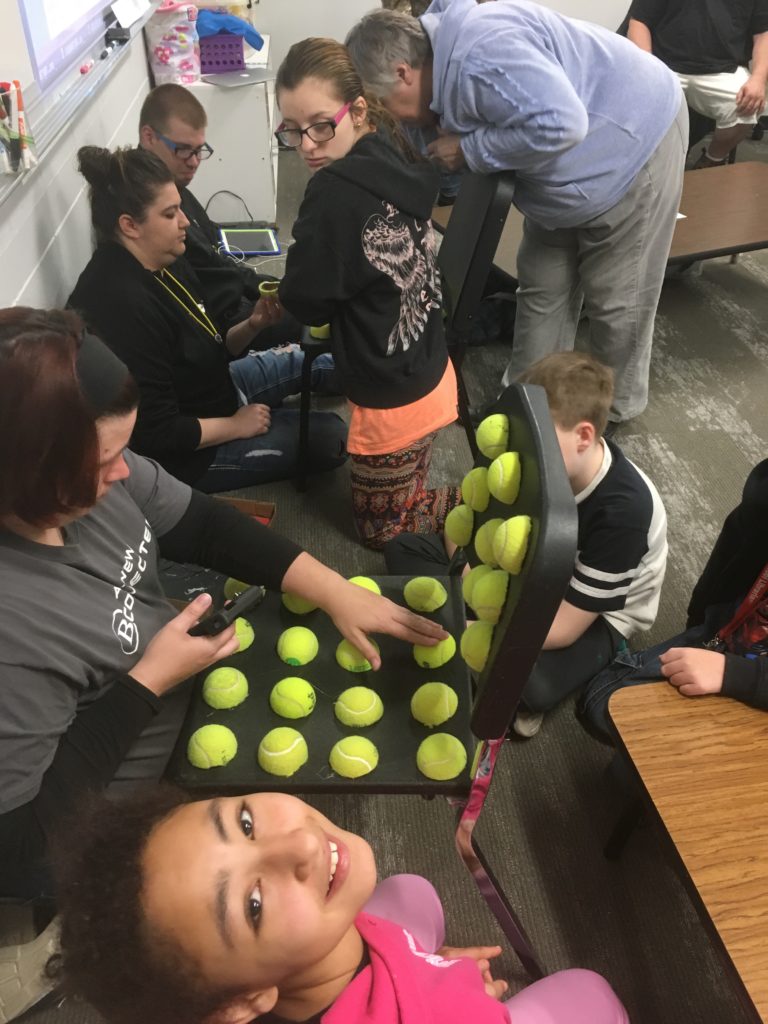
Once the tennis balls were cleaned and cut the students had to figure out the pattern that would work best for sensory input. They set out a few different patterns before finding one that was comfortable and would work for every students’ needs. The next step was to glue them to the chairs. They tried out 3 different kinds of glue. First, they started with hot glue and found that the student with Autism was easily able to pick them off. Then, they then tried clear caulking but this made a huge mess and didn’t stick to the plastic chairs very well. The winner was Gorilla glue.
Create Flexible Seating Rules
After the creation process was finished, the students decided that they needed to create usage rules that students are required to abide by when using each chair. This came about after a student stood on one of the bucket seats. The students also realized that in order to keep the chairs clean and damage-free for long-term usage that they needed to work together as a class to create specific rules. Thes students decided to hang the signs above each flexible seating option to remind students how to safely use each choice. This was a great way to end this project!!!! As a teacher, it’s AWESOME to see students think like a teacher and show pride in their work.
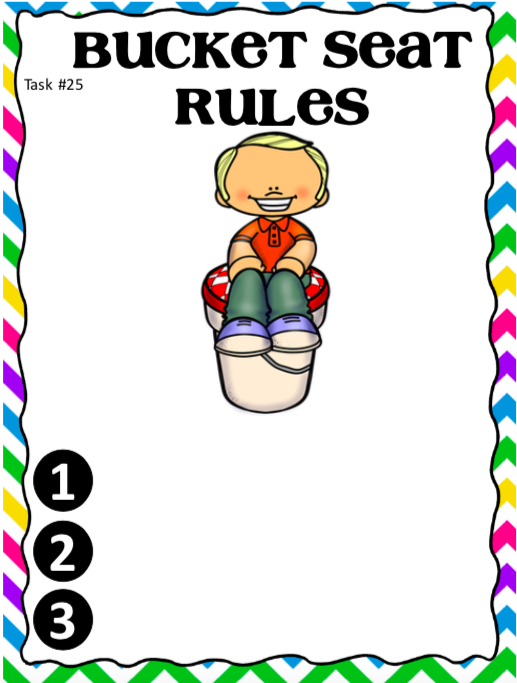
Need more project-based learning ideas? Check out my other PBLs here!
Exciting Announcement: Blog News!!!!
I have some really exciting news to share about my blog. I recently learned that my blog, instructionalcoaches.com has been chosen as one of the top 20 Education Blogs to follow in 2020 by FeedSpot!!! Check it out!!! My blog is #17. This is a HUGE honor that I am super EXCITED about!!!!!